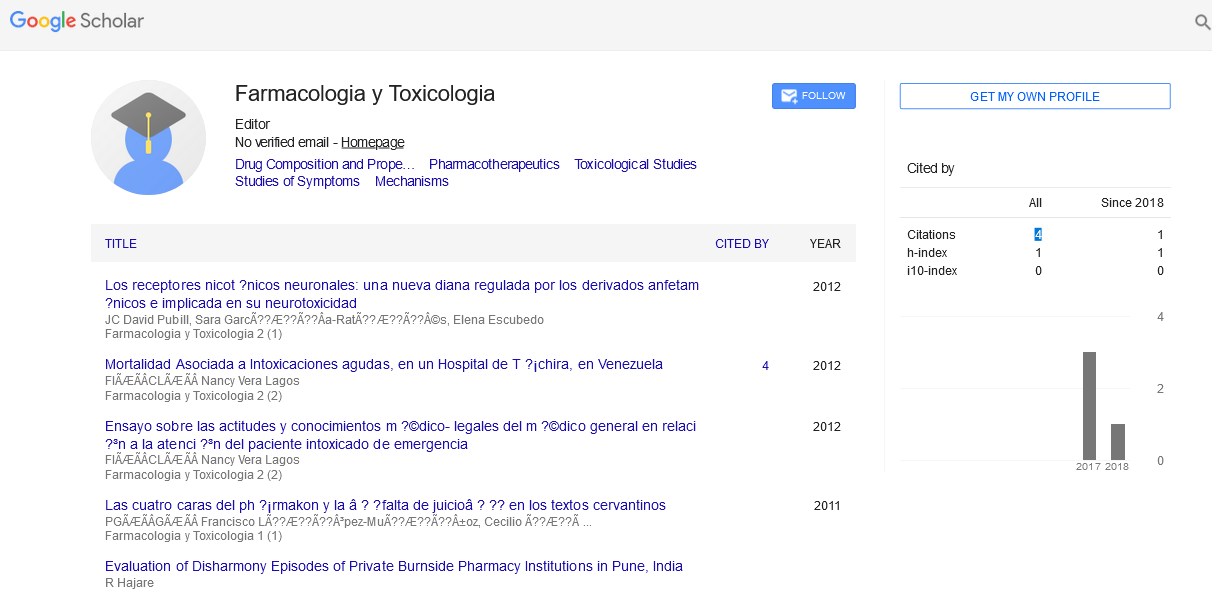Perspective - (2024) Volume 14, Issue 6
Carcinogenicity: Mechanisms, Risk Factors and Prevention
Oliver Lange*
Department of Toxicology, University of Ramkeimhang, Bangkok, Thailand
*Correspondence:
Oliver Lange, Department of Toxicology, University of Ramkeimhang, Bangkok,
Thailand,
Email:
Received: 07-Aug-2024, Manuscript No. IPFT-24-15138;
Editor assigned: 12-Aug-2024, Pre QC No. IPFT-24-15138 (PQ);
Reviewed: 26-Aug-2024, QC No. IPFT-24-15138;
Revised: 02-Dec-2024, Manuscript No. IPFT-24-15138 (R);
Published:
30-Dec-2024
Introduction
Carcinogenicity refers to the ability or tendency of a
substance, organism or exposure to cause cancer. Cancer, a
multifaceted disease characterized by the uncontrolled growth
and spread of abnormal cells, is influenced by a complex
interplay of genetic, environmental and lifestyle factors.
Carcinogens, the agents responsible for inducing cancer, can be
chemical, physical or biological in nature. This article explores
the mechanisms through which carcinogens cause cancer,
identifies common carcinogens and risk factors, and discusses
strategies for prevention and risk reduction.
Description
Mechanisms of chronic toxicity
Carcinogenesis, the process by which normal cells transform
into cancer cells, is typically a multistep process involving
initiation, promotion and progression.
Initiation: This is the first stage where the DNA of a normal
cell is damaged by a carcinogen. The damage may result in
mutations, which are changes in the DNA sequence. If the
body's repair mechanisms fail to correct these mutations, they
become permanent and can be passed on to daughter cells
during cell division. Initiation is a rapid and irreversible process.
Promotion: During this stage, the initiated cells undergo
further changes, stimulated by continuous exposure to the
carcinogen or other promoting agents. These promoting agents
do not directly cause DNA damage but facilitate the proliferation
of the mutated cells. Promotion is usually a reversible process if
the promoting agent is removed.
Progression: In the final stage, the promoted cells acquire
additional mutations that enable them to grow uncontrollably
and spread to other parts of the body. This stage involves
changes in the cell's structure, function and behavior, leading to
the formation of malignant tumors.
Types of carcinogens
Carcinogens can be classified into several categories based on
their nature and source:
Chemical carcinogens: These include a wide variety of
substances such as tobacco smoke, asbestos, certain dyes and industrial chemicals. Many chemical carcinogens are procarcinogens,
meaning they require metabolic activation within
the body to become active carcinogens. For example,
benzo[a]pyrene, found in tobacco smoke, becomes carcinogenic
after being metabolized in the liver.
Physical carcinogens: Physical agents such as Ultraviolet (UV)
radiation from the sun and ionizing radiation from X-rays or
radioactive materials can cause direct DNA damage leading to
cancer. UV radiation is a well-known risk factor for skin cancers,
while ionizing radiation is associated with cancers such as
leukemia and thyroid cancer.
Biological carcinogens: Certain viruses, bacteria and parasites
are known to cause cancer. Human Papilloma Virus (HPV) is
linked to cervical cancer, while Helicobacter pylori, a bacterium,
is associated with stomach cancer. These biological agents can
induce cancer through chronic infection, inflammation and the
introduction of oncogenes.
Risk factors and exposure
The risk of developing cancer due to carcinogen exposure
depends on several factors, including the dose, duration and
route of exposure, as well as individual susceptibility. Common
risk factors include:
Tobacco use: Smoking is the leading cause of lung cancer and
is also linked to cancers of the mouth, throat, pancreas and
bladder. The carcinogens in tobacco smoke include tar, nicotine
and other harmful chemicals.
Diet and alcohol: Certain dietary factors, such as high
consumption of red and processed meats, have been associated
with colorectal cancer. Excessive alcohol consumption is a risk
factor for cancers of the liver, mouth and esophagus. Alcohol can
act as a solvent, enhancing the penetration of other carcinogens
into cells.
Occupational exposures: Workers in certain industries may be
exposed to carcinogens such as asbestos, benzene and
formaldehyde. Occupational safety measures and regulations
are critical in reducing these risks.
Prevention and risk reduction
Reducing cancer risk involves a combination of lifestyle
changes, environmental measures, and medical interventions.
Lifestyle modifications: Quitting smoking, maintaining a
healthy diet rich in fruits, vegetables and whole grains, limiting
alcohol intake and engaging in regular physical activity can
significantly lower cancer risk. Weight management is also
crucial, as obesity is a known risk factor for several cancers.
Occupational and environmental safety: Adhering to safety
guidelines and regulations in workplaces where carcinogenic
exposure is possible is vital. Using protective equipment,
following proper handling procedures and minimizing exposure
to hazardous substances can help prevent occupational cancers.
Reducing environmental pollution through stricter regulations
and public awareness is also essential.
Vaccinations: Vaccines can prevent cancers caused by
infections. The HPV vaccine protects against the strains of the virus most commonly linked to cervical and other cancers. The
hepatitis B vaccine reduces the risk of liver cancer by preventing
hepatitis B infection.
Conclusion
Understanding carcinogenicity is crucial for developing
effective strategies to prevent cancer. By identifying and
mitigating exposure to carcinogens, making informed lifestyle
choices, adhering to safety regulations and utilizing medical
interventions, we can significantly reduce the incidence and
impact of cancer. Ongoing research and public health efforts
continue to play a vital role in the fight against this complex and
pervasive disease.
Citation: Lange O (2024) Carcinogenicity: Mechanisms, Risk Factors and Prevention. Farmacologia Toxicologia, Vol.14 No.6: 053





